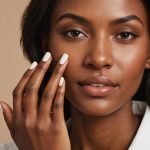Importance of Sunscreen Application Before Makeup
Sunscreen application is crucial in safeguarding skin against damage and premature aging caused by UV rays. These rays can penetrate the skin, breaking down collagen, leading to wrinkles and sunspots. By integrating UV protection into your daily routine, you can maintain a youthful appearance and healthy skin.
When it comes to makeup prep, sunscreen application plays a significant role in preserving the longevity of your makeup. UV rays can cause your makeup to break down more swiftly, affecting its overall appearance throughout the day. Ensuring your skin is shielded with sunscreen helps maintain a flawless look for longer periods.
Also to see : Create Your Custom Herbal Bath Soak: A Luxurious Recipe for Ultimate Skin Hydration and Revitalization
Understanding SPF is another vital aspect of sunscreen application. SPF, or Sun Protection Factor, measures a sunscreen’s ability to protect skin from UVB rays, which cause sunburn. Choosing a sunscreen with adequate SPF should be part of your daily routine, regardless of the weather, as it effectively prevents sunburn and other adverse effects of sun exposure. Adequate UV protection is imperative for both skin health and maintaining makeup integrity, making sunscreen application a critical step before makeup application.
Types of Sunscreen to Use with Makeup
Selecting the right sunscreen types is crucial for ensuring product compatibility and effective protection. Different formulations offer varied benefits, making your choice essential for optimal makeup prep.
Also to discover : Ultimate Guide to Selecting the Perfect Compression Gear for Optimal Post-Workout Recovery
Chemical vs. Physical Sunscreens
Chemical sunscreens absorb into the skin and convert UV rays into heat. They are lightweight and often provide a flawless makeup base. Conversely, physical sunscreens act as a barrier, reflecting UV rays. They may be preferable for sensitive skin but require more rubbing, which might affect makeup.
Tinted Sunscreens and Their Benefits
Tinted sunscreens merge skincare with cosmetic benefits, offering UV protection and a hint of colour. This dual-purpose product saves time and layers well, providing UV protection while evening out skin tone.
Mattifying Sunscreens for Oily Skin
For those with oily skin, mattifying sunscreens are ideal. They control shine and seamlessly blend with makeup. These formulations ensure that makeup stays in place without sliding off, effectively combining skincare with makeup prep. Choosing the right sunscreen type enhances both skin health and makeup appearance.
Step-by-Step Guide for Sunscreen Application
Achieving flawless makeup begins with proper sunscreen application technique. First, cleanse and moisturise your skin to create a smooth base. Ensuring your skin is clean before applying sunscreen enhances absorption and prevents pilling.
Next, apply sunscreen evenly before any other cosmetics. Experts recommend this order: sunscreen application, followed by primer, foundation, and other makeup products. This sequence ensures your sunscreen maintains its efficacy while allowing your makeup to sit properly.
When it comes to technique, use enough product – a nickel-sized amount for the face – and pat gently to avoid streaks. Avoid rubbing, as this can lead to uneven coverage and potential pilling, especially when layering products. If pilling occurs, reassess the amount used or the compatibility of products.
For a smooth finish, let the sunscreen absorb for a few minutes before proceeding with makeup. This waiting period is crucial to prevent a slick surface, which can impact how well your makeup adheres. By following these step-by-step instructions, you secure optimal protection and a beautiful makeup prep regimen. Proper application is key to maintaining the efficacy of sunscreen and ensuring long-lasting makeup.
Expert Tips for Longevity and Efficacy
To ensure sunscreen longevity and maintain a flawless appearance, experts recommend strategic reapplication techniques. Throughout the day, gently dab a sunscreen cushion or mist to replenish UV protection without disturbing your makeup. This keeps your skin safeguarded while looking fresh.
Selecting the right makeup products is equally crucial in a successful makeup prep routine. Opt for foundations and powders specifically formulated to layer over sunscreen, ensuring smooth blending and extended sunscreen efficacy. This prevents separation or cakiness, promoting a polished look.
Setting sprays with SPF are gaining popularity for their dual benefits, but their effectiveness can vary. These sprays can be useful for brief sun exposure, providing an extra layer of protection. However, they should not replace your regular sunscreen application. Use them as a supplementary step, especially during touch-ups.
By implementing these expert tips, you not only enhance the protective benefits of your sunscreen application, but also support the longevity of your makeup, ensuring both skin health and beauty are well-maintained. These insights serve as a guide to harmonize skincare with cosmetic routines effectively.
Common Mistakes to Avoid When Using Sunscreen
Incorporating sunscreen application into your routine is crucial, yet it’s easy to fall into common pitfalls. To enhance UV protection and maintain effective skincare tips, here are frequent mistakes to avoid:
-
Using insufficient product amounts is a widespread error. To cover your face effectively, apply a nickel-sized amount. This ensures comprehensive protection against UV rays. Skimping on coverage reduces SPF efficacy, leaving skin vulnerable to damage.
-
Disregarding expiration dates can compromise protection. Sunscreens lose potency over time, reducing their ability to guard against UV damage. Always check the date and replace expired products promptly to maintain optimal UV protection.
-
Rushing into makeup application without allowing sunscreen to absorb properly can lead to unsatisfactory results. Sunscreen needs a few minutes to set into the skin. Jumping to implementation too quickly can hinder effectiveness and cause makeup to slide or cake. Patience in this step yields better makeup prep.
Avoiding these errors is vital in optimizing your sunscreen routine, ensuring effective UV protection, and supporting your cosmetic practices efficiently. By being mindful of these aspects, you can maintain healthy skin and a lasting makeup look.
Visual Aids and Resources for Effective Application
Finding the right instructional resources can enhance your sunscreen knowledge and application skills. High-quality visual aids, like videos and infographics, provide helpful guidance for effective application.
Videos on Proper Application Techniques
Engaging video tutorials can be a practical tool to learn correct sunscreen application technique. These videos often offer step-by-step instructions, demonstrating how to apply the correct amount of sunscreen on various skin areas, ensuring complete UV protection. Watching these tutorials can reinforce learning and help avoid application errors.
Infographics on Sunscreen Types and Uses
Infographics present a succinct visual representation of information related to sunscreen types and their uses. They can help you quickly compare chemical and physical sunscreens or highlight ingredients that offer broad-spectrum protection, enhancing your understanding of product compatibility and formulations.
Expert Articles for Further Reading
For those seeking more comprehensive detail, exploring expert skincare articles can be invaluable. These articles delve deeper into SPF ratings, ingredient efficacy, and the science behind sun protection. Connecting with credible sources empowers you to make informed decisions tailored to your skincare needs.
Understanding SPF Ratings and Ingredients
Deciphering SPF ratings is key in sunscreen selection. SPF, or Sun Protection Factor, measures a product’s capacity to shield skin from UVB rays, which are predominantly responsible for sunburn. For optimal sunscreen knowledge, it’s crucial to select a rating that matches your skin type and UV exposure. A higher SPF offers extended protection against sunburns—a prudent choice for prolonged sun exposure.
The efficacy of sunscreen hinges on its ingredient composition. Look for active elements such as zinc oxide or avobenzone, known for offering broad-spectrum protection. These components absorb or reflect both UVA and UVB rays, preventing skin ageing and sunburn.
Emphasising broad-spectrum protection is vital for complete skincare. Broad-spectrum sunscreen defends against UVA rays that penetrate more deeply, leading to aging and increased skin cancer risk. This type effectively safeguards skin health by offering comprehensive coverage, thereby reducing UV-induced damage. By understanding these components, you empower your skincare regimen and defend against adverse sun effects efficiently.

